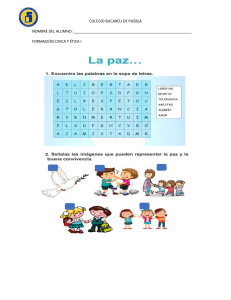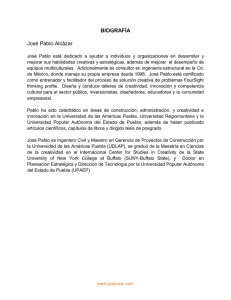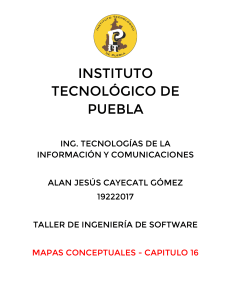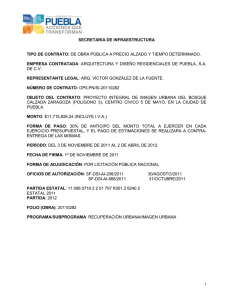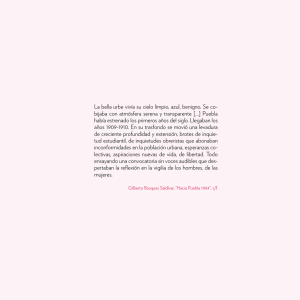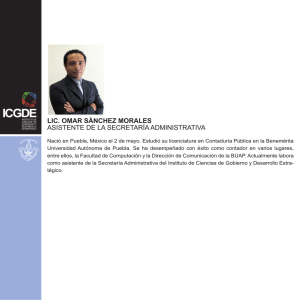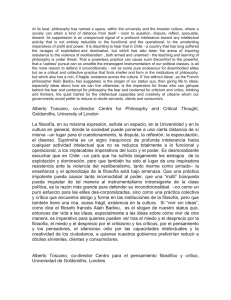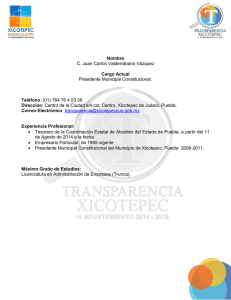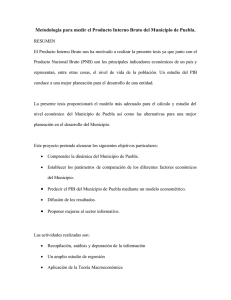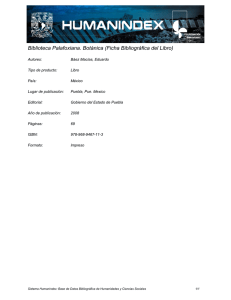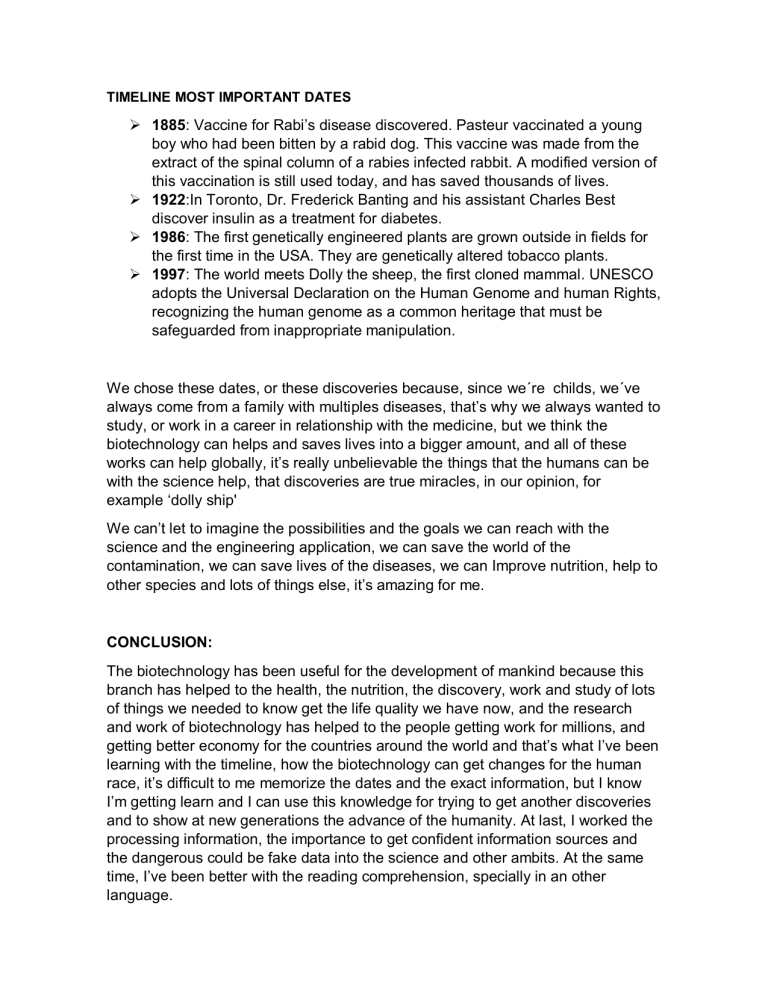
TIMELINE MOST IMPORTANT DATES ➢ 1885: Vaccine for Rabi’s disease discovered. Pasteur vaccinated a young boy who had been bitten by a rabid dog. This vaccine was made from the extract of the spinal column of a rabies infected rabbit. A modified version of this vaccination is still used today, and has saved thousands of lives. ➢ 1922:In Toronto, Dr. Frederick Banting and his assistant Charles Best discover insulin as a treatment for diabetes. ➢ 1986: The first genetically engineered plants are grown outside in fields for the first time in the USA. They are genetically altered tobacco plants. ➢ 1997: The world meets Dolly the sheep, the first cloned mammal. UNESCO adopts the Universal Declaration on the Human Genome and human Rights, recognizing the human genome as a common heritage that must be safeguarded from inappropriate manipulation. We chose these dates, or these discoveries because, since we´re childs, we´ve always come from a family with multiples diseases, that’s why we always wanted to study, or work in a career in relationship with the medicine, but we think the biotechnology can helps and saves lives into a bigger amount, and all of these works can help globally, it’s really unbelievable the things that the humans can be with the science help, that discoveries are true miracles, in our opinion, for example ‘dolly ship' We can’t let to imagine the possibilities and the goals we can reach with the science and the engineering application, we can save the world of the contamination, we can save lives of the diseases, we can Improve nutrition, help to other species and lots of things else, it’s amazing for me. CONCLUSION: The biotechnology has been useful for the development of mankind because this branch has helped to the health, the nutrition, the discovery, work and study of lots of things we needed to know get the life quality we have now, and the research and work of biotechnology has helped to the people getting work for millions, and getting better economy for the countries around the world and that’s what I’ve been learning with the timeline, how the biotechnology can get changes for the human race, it’s difficult to me memorize the dates and the exact information, but I know I’m getting learn and I can use this knowledge for trying to get another discoveries and to show at new generations the advance of the humanity. At last, I worked the processing information, the importance to get confident information sources and the dangerous could be fake data into the science and other ambits. At the same time, I’ve been better with the reading comprehension, specially in an other language. INVESTIGAR UNA NECESIDAD BIOTECNOLÓGICA EN EL ÁREA DONDE RESIDO. (ESPAÑOL) EL AGUA POTABLE EN EL ESTADO DE PUEBLA PROVOCA AFECTACIONES DERMATOLOGICAS. Problemática: El agua potable utilizada en el área conurbada de Puebla, contiene muchas sales y minerales dañinos para la piel. Incluidas bacterias que son causantes de demás afectaciones cutáneas. Afectaciones tópicas: - Caspa Dermatitis atópica Alergias cutáneas Cuero cabelludo secreción sebácea Lupus Dermatomiositis Necesidad: Reducir la cantidad de minerales, sales y bacterias que proliferan en las cisternas de agua existentes en la ciudad de Puebla. Solución: Instalar filtro de sedimento anti bacterias filtración semi- absoluta filtro de osmosis inversa. Funcionamiento: Tecnología de membrana que permite eliminar la salinidad del agua. Proceso de difusión a través de una membrana semi permeable que facilita el paso de gases disueltos y moléculas sin carga electroestática de bajo peso molecular. Los filtros anti bacterias o lo que es l mismo, con efecto bacteriostático, previene el crecimiento bacteriano y no permite la proliferación de microorganismos que pudiesen aparecer a lo largo del tiempo de uso. Fabricación: 100 % polipropileno y plata anti bacterias de grado alimentario. 4 fases (cartuchos) Fase 1: Doultan de cerámica proporciona la sub filtración Fase 2: Incorporación de plata impregnada dentro de la estructura de cerámica, Inhibe el crecimiento de bacterias y da características de auto esterilización bacteriostática. Fase 3: Base interna de carbón activado en bloque, que resta el cloro y los solventes industriales. fase 4: Resina de intercambio iónico, reduce le plomo y otros metales pesados. Retención de sedimentos: - 1 micra: 82% de 1 micra 99% de 5 micras y mayores 5 micras: 82% de 5 micras, 99% de 10 micras y mayores. Conclusión: Con la aplicación de filtro de sedimento anti bacterias de filtración semi-absoluta, se puede reducir la cantidad de bacterias, sales, minerales que abundan en el agua potable utilizada en la urbe de Puebla; ya que, al contar con tecnología de filtrado bactericida con características de auto esterilización, puede aplicarse en las “cisternas” de la población, reduciendo las afectaciones dérmicas, hasta en un 80% Fuentes bibliográficas: https://jhuesa.com//tecnologias/osmosis-inversa Literatura: “Los servicios de agua potable y saneamiento de Puebla” BUAP 1ra edición 2014 TO INVESTIGATE A BIOTECHNOLOGICAL NEED IN THE AREA WHERE I LIVE. (ENGLISH) DRINKING WATER IN THE STATE OF PUEBLA CAUSES DERMATOLOGICAL AFFECTATIONS. Problem: The drinking water used in the conurbation area of Puebla, contains many salts and minerals harmful to the skin. Including bacteria that cause other skin disorders. Topical affections: - Dandruff - Atopic dermatitis - Skin allergies - Scalp sebaceous secretion - Lupus - Dermatomyositis Necessity: Reduce the amount of minerals, salts and bacteria that proliferate in existing water cisterns in the city of Puebla. Solution: Install anti-bacteria sediment filter semi-absolute filtration reverse osmosis filter. How it works: Membrane technology to remove salinity from water. Diffusion process through a semi-permeable membrane that facilitates the passage of dissolved gases and molecules without electrostatic charge of low molecular weight. Anti-bacterial filters or what is l same, with bacteriostatic effect, prevents bacterial growth and does not allow the proliferation of microorganisms that could appear throughout the time of use. Manufacture: 100 % polypropylene and food grade anti-bacterial silver. 4 phases (cartridges) Phase 1: Ceramic doultan provides the sub filtration. Phase 2: Incorporation of silver impregnated within the ceramic structure, inhibits bacterial growth and provides bacteriostatic self-sterilization characteristics. Phase 3: Internal activated carbon block base, which subtracts chlorine and industrial solvents. Phase 4: Ion exchange resin, reduces lead and other heavy metals. Sediment retention: - 1 micron: 82% of 1 micron 99% of 5 microns and larger - 5 micron: 82% of 5 micron, 99% of 10 micron and larger. Conclusion: With the application of anti-bacterial sediment filter of semi-absolute filtration, it is possible to reduce the amount of bacteria, salts, minerals that abound in the drinking water used in the city of Puebla; since, having bactericidal filtering technology with self-sterilization characteristics, it can be applied in the "cisterns" of the population, reducing the dermal affectations, up to 80%. Bibliographic sources: https://jhuesa.com//tecnologias/osmosis-inversa Literature: "Drinking water and sanitation services in Puebla" BUAP 1st edition 2014. Translated with www.DeepL.com/Translator (free version) TEAM: AHUMADA PULGARON PAULA MELISSA CASTREJON AGUAYO SONIA CAMILA CISNEROS PAREDES LINETTE VALERIA AVILA SOLEDAD ANA BELEN LOZANO VELAZQUEZ FRANCISCO SAEL BENAVIDEZ MARTINEZ DAPHNE
